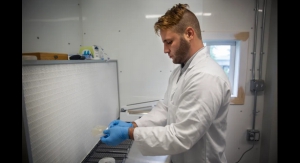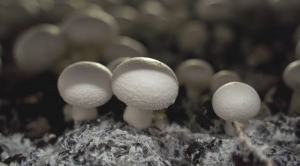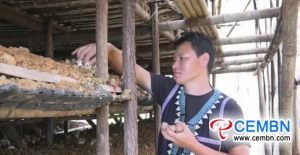Abstract
Mushroom cultivation on common reed (Phragmites australis) substrates is a new research area. The yield distribution and nutrient changes in mushroom flushes were studied using a reed to cultivate golden oyster mushrooms (Pleurotus citrinopileatus).
The results showed that cultivating mushrooms on reed substrates resulted in different flushes of mushrooms. The biological efficiencies were found to be 69.10 % for three (FF) and 75.98 % for four (MF) flushes, respectively. Significant reductions in crude protein content (from 28.28 % to 18.35 %) were observed, while total sugar content increased from 24.86 % to 36.95 % from the first to fourth flushes under MF treatment. However, no significant differences in crude protein or total sugar were observed between FF-treated flushes. Calcium concentrations increased, while heavy metal concentrations were lower than the toxicity safety standards. In the cultivational room, inhomogeneous environmental conditions led to changes in the number of flushes, as well as altered nutrient quality and overall production when using the same substrate to cultivate the same type of mushroom.
Mushrooms are widely consumed around the world as a nutrient-dense food source with numerous health benefits. Oyster mushrooms (Pleurotus spp.) are particularly popular due to their high levels of fat-soluble vitamins and essential minerals, as well as their low sodium and fat content (Abou Fayssal et al., 2021). Oyster mushrooms are widely cultivated because they can grow on a variety of substrate materials, have a relatively short cultivation period, and a low production cost (Mahari et al., 2020a). Their growing popularity is due to their ease of cultivation, high yield potential, and medicinal and nutritional value (Chang, 2006).
Please read the full article here.
Source: ScienceDirect
If there is one thing that excites Josh Peitzman, it’s the promise of rain.
A saturated forest floor is a fungal breeding ground, and Peitzman, 24, spends much of his free time post-rain on the hunt for mushrooms to identify. It’s become second nature for him to walk through Granger's Jester Park, eyes on the ground or in the nooks and crannies of trees, in search of something new to discover.
For a time, this hobby — which began five years ago — was just that. The self-taught mycologist foraged and identified, learned the taxonomic names of the species he’d uncover and eventually started tinkering with mushroom grow kits and still air boxes. Soon, however, he began picturing a future beyond his dishwashing job at Wasabi in Ankeny — a future in which he’d cultivate his own mushroom farm and fulfill a longstanding dream of following in his grandfather’s farming footsteps.
That mushroom farm, Fungi Fresh Farms, is now a reality. With support from investor-turned-business partner Jerrod Appenzeller, Peitzman is determined to grow the largest gourmet mushroom farm in central Iowa in a renovated shipping container in Grimes. Just months into production, Peitzman and Appenzeller are harvesting 50 to 100 pounds of specialty mushrooms per week for local farmers markets, restaurants and CSAs (community supported agriculture farm operations), but the two say it is just the start.
Please read the full article here.
Source: Des Moines Register
Mushroom Life Cycle Assessment
Gentle on the Planet
Stakeholders across the food product supply chain are increasingly interested in understanding the environmental effects of food production. Mushrooms have a unique growing process unlike any other produce item and are considered “one of the most sustainably produced foods in the United States1.” Consider this:
- They are grown in the absence of sunlight in a climate-controlled environment.1
- One pound of production requires only 1.8 gallons of water; 1.0 kilowatt hours of energy; generates only .7 pounds of CO2 equivalent emissions.1
- Up to 1 million pounds produced on just 1 acre.1
A 2018 study2 published in the International Journal of Life Cycle Assessment looked at the cradle-to-gate life cycle environmental impacts of mushroom production in the United States from cultivation to harvest and preparation for bulk packaging. The goal was to create a “baseline” estimate of energy use, global warming potential (GWP), water use, and other common environmental impacts.
Please read the full article here.
Mario (Chuff) D. Basciani, a mushroom industry pioneer whose work ethic, tenacity and passion for mushrooms made him a role model to farmers throughout the country, died Sunday, Sept. 13, surrounded by his loving family. He was 91.
Mr. Basciani was a second-generation mushroom farmer, founder of Basciani Foods Inc., and patriarch of the Basciani family. He is survived by his wife of over 70 years, Anna, his five children, 18 grandchildren, and 40 great-grandchildren.
Mr. Basciani was born Jan. 20, 1929 in Toughkenamon, PA, to Italian immigrants Emedio and Anna Basciani. His father started harvesting mushrooms for the Pratt family in 1915, until he established his own farm in 1925. Mr. Basciani began working on the family farm at a young age and fell in love with all aspects of the business, especially the challenging physical work that comes with cultivating mushrooms.
Read the full article here.
Source: The Produce News
On July 3, Brazil mushrooms farmed in mushroom base of Nanyou Village, Malipo County, Yunnan Province of China are evolving into the maturation, growers are busy with mushroom picking, sorting, drying and marketing.
“Brazil mushroom farming is short in cultivation period, from the formal cultivation to marketing, Brazil mushrooms only take 60 days or so. Now, it is the GOLDEN picking season of Brazil mushroom, in each shed, daily picking volume could reach 1500 kg or so, for growers like us, daily net incomes could come to over 10,000 CNY,” introduces one of local mushroom growers passionately, going on that by 2020, 10-12 flushes of Brazil mushroom are expected to be realized and cultivated, the anticipated gross output attains at least 312 tons while the projected annual output value hits 2.8 million CNY in Nanyou Village.
Gasa monks take up oyster mushroom cultivation
Monks and agriculture. It is a sweet combination and a lesson on sustainability.
In Gasa rabdey, the monks, their robed folded high up, are preparing mushroom cultivation. Fifteen monks even underwent a two-day training on fungiculture.
The training, Umzey Tshering Dhendup said, came after the agriculture officials came to enquire if the monks would be interested in growing their own food.
“After Covid-19, we had to think about the importance of agriculture,” he said. “Monks also need such skills.”
Gasa dratshang spends about Nu 70,000 to buy vegetables every month. The expenditure is covered from the stipends the monks receive. From Nu 1,400 that each monk receives, Nu 1,000 is set aside to procure vegetables.
In a corner of the dratshang’s storehouse are 60 bags of oyster mushroom seeds. In five weeks, the dratshang can harvest at least 60kg mushroom.
A kg of oyster mushroom sells for Nu 200 in market.
For the full article, click here























